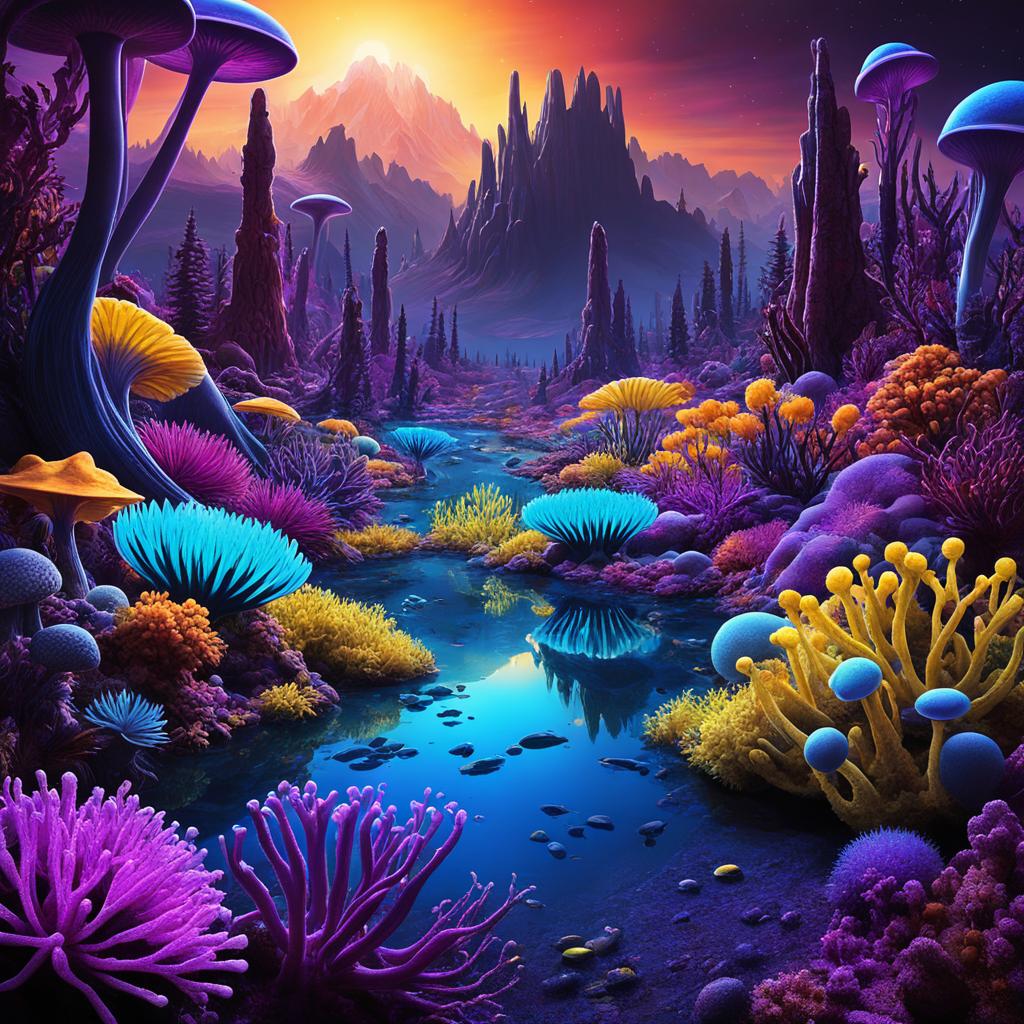Over 5,000 exoplanets have been found in our Milky Way galaxy, and there are many more to be discovered. This shows just how big the universe is and the exciting chance that we are not the only life out there. The study of life in the universe, known as Astrobiology, is more interesting than ever.
There was a memorable time when Sarah Stewart Johnson found a tiny fern on a volcano in Hawaii. It was a big moment. Now, NASA and others are looking for other kinds of life in the universe. The question persists: are humans the only living beings in the vast space, or is there more to discover?
The Quest to Find Alien Life
The hunt for alien life has long fascinated scientists. With a desire to find life elsewhere, they have worked hard to solve universal mysteries. Their efforts have significantly moved the field of astrobiology forward.
The Hunt for Habitable Exoplanets
Researchers focus on exoplanets in their search. These planets circle stars beyond our own. The Kepler mission by NASA has found many exoplanets, some even in the habitable zone of their stars.
This discovery broadens our knowledge of planetary systems. It helps us see the potential for signs of life, known as biosignatures, on other planets.
Space Exploration and the Search for Biosignatures
Tools like the Hubble Telescope and James Webb Telescope, along with Mars missions, push the search ahead. They can study exoplanet atmospheres for signs of life.
Learning from extremophiles boosts this effort. These are time forms thrived in extreme Earth spots. Wondering about their counterparts in outer space, scientists are curious about life’s adaptability.


Scientists hold out hope that with new technology and more knowledge, we may find life elsewhere. This quest makes us ask: Is Earth the only place with life in the universe?
Astrobiology: Unraveling the Mysteries of Life
The search for life beyond Earth is both exciting and complex. It looks deeply into the meaning of life. Astrobiology is the study of life outside Earth and our life’s beginning and change.
There is no single definition of life in astrobiology. According to Edward Trifonov, life is about self-reproduction with changes. NASA says it’s a chemical system that can evolve by Darwinian rules. These views suggest there might be unknown forms of life (life as we don’t know it (LAWDKI)).
The Arizona Astrobiology Center at the University of Arizona is a hub for research. More than 40 experts from different fields work together. They aim to solve universal mysteries and study life’s origin, including life off Earth.
At the University of Hawaiʻi at Mānoa, researchers have found important molecules. These come from environments like the Taurus Molecular Cloud and Titan. The molecules, including pyridine, help form amino acids and nucleic acids. This work sheds light on how life’s basis could have started.
“The creation of the Arizona Astrobiology Center signifies a commitment to unraveling the mysteries of the universe, understanding life’s origins, and exploring the possibility of life beyond Earth.”
As we keep learning about life, astrobiology is key. Experts from many fields work together, pushing the limit of what we know. They aim to find out what’s out there beyond our world.


Life as We Know It: DNA and Genetic Code
Our world’s biology is rooted in DNA, or deoxyribonucleic acid. It has a unique structure with two twisted strands. These strands hold sugar and phosphate groups, with bases like A (adenine), G (guanine), C (cytosine), and T (thymine) attached to the sugar. These bases, together with the backbone, form the building blocks of life.
DNA is essential, but RNA (ribonucleic acid) is also key. RNA helps in turning DNA’s instructions into proteins. It’s like DNA but with the base uracil (U) instead of thymine (T).
Variations in Nucleic Acids and Genetic Materials
Scientists have noticed how DNA and RNA can be different. They even made synthetic DNA and XNA, which uses other unknown molecules. This shows us that life may exist in forms we aren’t familiar with.
| Terrestrial Biology Statistics | Findings |
|---|---|
| Estimated water inventory on Mars | Ranges from tens of meters to approximately 1 km global equivalent layer |
| Land area on early Earth | Little to no sub-aerial continental crust before 3.5 billion years ago, reaching 1-2% by 3.0 billion years ago and 5-8% by 2.5 billion years ago |
| Genetic code fixation and oxidation on early Earth | Separated in time by more than 1 billion years |
| Subsystems of a cell | Utilize amino acids, nucleic acids, and lipids for metabolic, informational, and compartment-forming |
These facts show the changing face of biology on Earth. They suggest there could be other ways, even beyond DNA and RNA, life could develop. It’s an exciting idea that we hope to explore more in space.
Life as We Don’t Know It (LAWDKI)
Scientists are looking for life beyond our planet and questioning what life really is. Leroy Cronin from the University of Glasgow says our idea of life might not fit elsewhere. He thinks we should search for “astro life.” This is life forms that might work differently from what we’re used to seeing on Earth.
The idea of “LAWDKI” is catching on in astrobiology. Stuart Bartlett from the California Institute of Technology talks about “lyfe.” This term is for any system that shows the signs of something living but doesn’t fit Earth’s life examples. This new way of thinking shows us that life could look very different than we imagine. It makes us rethink what being alive really means.
Expanding Our Understanding of Alien Biochemistry
People are looking at other possible biochemistries that might support life from beyond our planet. 

Scientists are pushing the limits of what we think life is. They’re open to new ideas on what life could be like on other planets. By learning more about alien biochemistry, we could find out that life in the universe is much more varied than we imagined.
The Laboratory for Agnostic Biosignatures (LAB)
In the hunt for life beyond Earth, scientists are going further than the basic rules of Earth’s biology. The Laboratory for Agnostic Biosignatures (LAB) is breaking new ground. It’s backed by NASA and spearheaded by Sarah Stewart Johnson. LAB looks for the very essence of life, aiming to spot it, no matter its form.
Searching for Fundamental Markers of Biology
LAB stands out from past missions by not expecting life to be Earth-like. Instead, it follows a wide-open approach. The team seeks out signs of complexity and imbalance as hints of life, no matter its chemistry.
The LAB team melds various expertise, from biology to engineering. They’re diving into many areas. These include the study of how life became multicellular, the sharing of resources (syntrophy), and adapting to survive in harsh conditions (phenotypic plasticity).
| Key Researchers | Areas of Focus |
|---|---|
| William Ratcliff | Evolution of multicellularity in microorganisms |
| Chris Kempes and Jordan Okie | Likelihood and significance of acquiring organelles like mitochondria through eco-evolutionary modeling |
| Maëva Milan | Physio-chemical analysis using pyrolysis and wet chemistry, coupled to gas-chromatography mass-spectrometry in the investigation of organic molecules and biomarkers on Mars |
| Lu Chou | Understanding the relationship between chemical complexity and mass spectrometry data for potential biosignatures on planetary bodies like Mars or Titan |
| Catherine Maggiori | Exploring agnostic biosignatures and the detection of life forms not known to us |
| Maggie Weng | Microbial ecology of extremophiles, exploring how life thrives in extreme environments |
| Nicolas Wagner | Merging physics and biology background to study life in extreme environments as Mars analogs |
The LAB’s unique strategy attracted a lot of funding. The University of Texas at Austin received $722,000 from NASA. They also got $400,000 from the National Science Foundation. In total, the LAB project got $7 million. It involves 15 experts from 10 institutions around the globe.
By daring to look where few have, LAB is changing the game in how we define life. Its work could lead to game-changing finds, pushing our hunt for signs of life beyond our planet.


Defining Life: Self-Reproduction and Evolution
Scientists are looking hard for life beyond Earth. This hunt makes them ask, what is life really? Experts in space life, or astrobiologists, have argued over this for a long time. They say life is a system that can make copies of itself and evolve. Anything without this ability is not what we consider alive.
This NASA view helps us understand what makes living things special. It’s about making more of themselves and changing over time. We learn a lot by studying life on Earth. But, what we think aliens might be like doesn’t always match this definition. It’s a tricky business to say what life is, especially for strange places out there.
We think of life in many ways. For biologists, it’s not easy to pin down exactly what it is. But, knowing exactly helps fields like astrobiology and synthetic biology. They look for life in new or unusual forms. Yet, not agreeing on what life really is can slow down these areas of study, as scholars Oliver and Perry say.
Searching in space, astrobiologists study organics and water, key signs of life. They guess there might be life out there not like ours. This might involve different building blocks. So, they look at many possibilities to find out what life could be beyond what we know.
People keep debating what life is because it’s not simple to define. This thinking shows the hard work scientists face. They want to know how life started and where it could be. A good definition will help in the big hunt for other kinds of life, giving us insight into the universe.


The Origins of Life on Earth
Scientists are on a mission to find out how life started on Earth. They look at two main ideas: the “RNA world” and the “metabolism-first.” Each theory gives a different view on how life’s basic parts began and then came together to form living things.
RNA World and Metabolism-First Hypotheses
The first idea, the RNA world, says that life began with RNA. RNA can store genetic data and help chemical reactions. This theory suggests that self-replicating RNA made the first steps towards life.
The second idea, metabolism-first, focuses on chemical reactions. It says life started by organizing reactions. Then, these organized reactions led to the genetic code and the ability to make more life.
Both ideas have their own support. But many researchers think they might work together. By combining these views, we could learn a lot about the start of life on our planet.
“The origin of life is one of the greatest unsolved mysteries in science, and understanding it is a primary goal of astrobiology.”
While the search for Earth’s life origins goes on, scientists are also looking into life beyond our planet. Ideas from astrobiology help us explore life’s beginnings and futures. This field keeps expanding our understanding, reaching out into the vastness of space.
Future Exploration for Extraterrestrial Life
The search for life beyond Earth has always interested people. The James Webb Space Telescope will push this further, offering great chances for new discoveries.
The James Webb Space Telescope’s Potential
The James Webb Space Telescope was sent to space in 2021. It might help us see what gases are in the air of planets like ours. This is important because finding gases like oxygen or methane could mean life is there.
Scientists also look for signs of plants or technology. They might find clues of this, like signs of pollution or photosynthesis in the air. This would be exciting evidence for life beyond Earth.
Detecting Atmospheric Biosignatures on Exoplanets
The focus in space is now on finding biosignatures on planets beyond our solar system. These are special mixes of gases that may point to life. Working out what’s in the air of these distant worlds may find proof of life.
The future of looking for extraterrestrial life is looking good. With the James Webb Space Telescope up there and other new tools, we could make big steps. It’s a thrilling journey as we learn more about life in the universe.
“The discovery of extraterrestrial life, however primitive, would be perhaps the most momentous revelation in human history.”
Conclusion
Searching for life beyond Earth is both fascinating and hard. Scientists ask big questions about what life is. As our tech gets better, we might soon find out if we’re not alone. This search is ongoing, but astrobiology keeps moving forward. We might make big discoveries soon.
NASA has put a lot of effort into astrobiology, a mix of different sciences. People are hopeful for answers, but this research takes time. Patience is key in astrobiology, as breakthroughs don’t happen overnight.
New findings in astrobiology can really shake things up. The field might change its ways and find new methods. With more discoveries happening now than before, the hunt for life in space is very exciting. This work helps us learn about the universe and where life comes from.
Source Links
- https://www.scientificamerican.com/article/the-search-for-extraterrestrial-life-as-we-dont-know-it/
- https://astrobiology.nasa.gov/about/
- https://www.nationalgeographic.com/astrobiology/
- https://ncse.ngo/astrobiology-and-search-alien-life
- https://www.scientificamerican.com/article/in-the-search-for-alien-life-ldquo-everyone-is-an-astrobiologist-rdquo/
- https://astrobiology.nasa.gov/about/history-of-astrobiology/
- https://astrobiology.com/2023/10/university-of-arizona-launches-arizona-astrobiology-center-to-unlock-the-mysteries-of-life-in-the-universe.html
- https://astrobiology.com/2024/05/uh-manoa-scientists-help-unravel-lifes-cosmic-beginnings.html
- https://www.biotechreality.com/2023/08/astrobiology-unraveling-the-mysteries-of-life-beyond-earth.html
- https://www.ncbi.nlm.nih.gov/pmc/articles/PMC9298492/
- https://www.psu.edu/news/research/story/astrobiology-search-life-universe/
- https://www.theguardian.com/science/2013/apr/14/shadow-biosphere-alien-life-on-earth
- https://thealphacentauri.net/130976-poisk-vnezemnoy-jizni-kakoy-my-ee-ne-znaem/
- https://www.umu.se/en/research/groups/eric-libby-lab/
- https://news.utexas.edu/2019/01/04/two-ut-scientists-helping-to-detect-life-as-we-dont-know-it/
- https://www.johnsonbiosignatureslab.com/team-2
- https://www.ncbi.nlm.nih.gov/pmc/articles/PMC3005285/
- https://www.ncbi.nlm.nih.gov/pmc/articles/PMC3937540/
- https://philsci-archive.pitt.edu/18699/1/life OUP v5 revision final.pdf
- https://ncse.ngo/astrobiological-perspective-lifes-origin
- https://formaspace.com/articles/aerospace/what-can-astrobiology-space-research-teach-us-about-the-origins-of-life/
- https://www.ncbi.nlm.nih.gov/pmc/articles/PMC7568464/
- https://www.nature.com/articles/s41526-023-00292-1
- https://astrobiology.com/2024/06/marine-science-can-contribute-to-the-search-for-extra-terrestrial-life.html
- https://www.esa.int/Science_Exploration/Human_and_Robotic_Exploration/Exploration/Extraterrestrial_life
- https://nap.nationalacademies.org/read/10454/chapter/9
- https://www.ncbi.nlm.nih.gov/books/NBK220841/
- https://oxfordre.com/planetaryscience/display/10.1093/acrefore/9780190647926.001.0001/acrefore-9780190647926-e-1?fbclid=IwAR0-gzVVFEgQvHZAwd6U8d4pHtlHYJ45eWRbRa3XxMIV9mZ7t-9aT7bv06M
